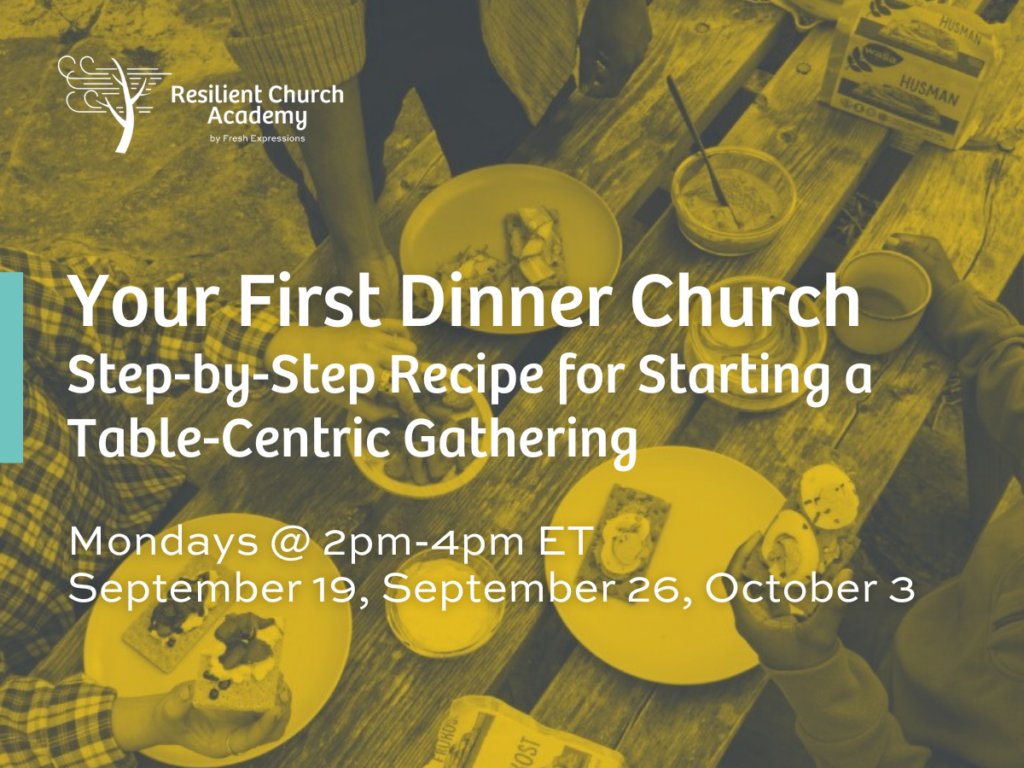If you are excited about starting a new expression of church, such as a Dinner Church, you may struggle to discuss this with people in your congregation. New things, new ways can be a challenge to establish practices.
When we talk about “church” there are some regular words that describe the activities and ministry churches employ: worship, teaching, preaching, outreach, fellowship, mission, discipleship, evangelism, stewardship, children’s ministry, youth ministry, etc.
We can compartmentalize these actions and speak of them distinctly. This may be helpful in some large church settings with departments for these various and specialized works.
However, Dinner Church is not a “ministry,” but a fully formed expression of Church. Although it gathers in a different way than most churches, it expresses God’s mission to form communities of people who are like Jesus.
God is on a mission, and the Church is a result. Sadly many local congregations primary mission is sustaining their current ministry. Moreover, not everyone has been taught that God has a mission, and end up seeing their church as an institution that serves their own need for relationship and spiritual experiences.
We need to help people understand the church is a part of God’s mission, and that can look very different.
What is an Ecclesia?
One way to help people understand there are many expressions of church is to think about “programs.” What is often called a program or an outreach is really best understood as an actual congregation, a faith community doing life together, possessing all the attributes typically attributed to a historic and traditional church.
This was true of the youth ministry I led way back when. In those days, we would never have called it a church on its own but in reality it functioned like the kind of community Jesus envisioned and commissioned. We were an assembly of Christ followers, living in a deep level of relationship, engaged and growing in our knowledge and love of the Lord. That group of people that lived in that ministry are bound together some 30 years later as we see it expressed in social media, maintaining profound connection with one another.
Dinner Church is Nothing New
We have to be willing to plant new types of churches in our changed world. Dinner Church is a prime example, and we often get pushback from traditionally minded folks who view Dinner Church as an outreach, a fellowship, a gathering when in reality it is an authentic and ancient expression of what Jesus commissioned us to be and do.
When we read the Gospels and the Book of Acts, we bear witness to people choosing to follow Jesus and were folded into a communal way of life. To be honest, I have been a late-comer to the series The Chosen but now have become a fan. I witness in this telling of the story of Jesus a different understanding of what it means to be the church. It is less about buildings, structures, formality, rules and more about people seeing and understanding who Jesus is and how he wants to revolutionize the human experience. He heals, teaches and eats his way into forming a meaningful existence.
The early church gathered around a table for a meal, they laughed, had conversation and talked about the mission they were on, ultimately to change the world. They shared their own Jesus Stories and how an encounter with this Carpenter from Nazareth transformed their lives. Doesn’t that sound inviting?
The Christendom Problem
Many church people linger in a Christendom mindset. This word describes life in previous generations where Christianity was at the center of the culture in North America. In reality the cultural west has moved beyond this and relegated the institutional, denominational church to moments such as Royal Weddings and State Funerals. The cultural west has moved on into Post-Christendom with Christianity in the rear-view mirror.
We clearly are in a changed world from 50, 30 or even 5 years ago. We need to understand that our Christendom models are not on the front-line of effectiveness and many if not most simply will not reach the least, lost and wandering people that God loves. A Christendom model does not work in a Post-Christendom world. We need an ancient model and Dinner Church fulfills that purpose.
Getting someone these days who has no church experience at all to cross the threshold and go through the doors of a traditional church is a major and challenging task. Inviting people to a meal for conversations about life, from the normal, routine circumstances of day to day living or even to greater issues of meaning and purpose can be less threatening around a table.
When we talk about Dinner Church we need to look back and see a church gathered in daily fellowship around a table. A table that breathes kindness, compassion, mercy, understanding, peace and especially faith, hope and love.
Four Keys to Introducing Dinner Church
Although your conversations about Dinner Church will vary, I find that there are four keys to helping people understand how it will work.
- Dinner Church is doable. Church people if anything know how to put on a potluck! This is in our wheelhouse and history from fellowship dinners to church picnics and Dinner on the Grounds. People need to eat and carve out typically 3 times a day to do so. Jesus ate with people, fed people (thousands) and established the ongoing mission of the church in a covenant meal. It tells us FOOD IS IMPORTANT – but we already knew this!
- Dinner Church is inviting. The table is not threatening. Many restaurants are trending (Starbucks, Burger-Fi, Panera’s) as we see some install large community tables where strangers share space as they grab a meal. Many eat and stare at their phones, but there are some authentic and engaging conversations that emerge. Most people when offered a seat at a table take it and are maybe even honored in this gesture of hospitality.
- Dinner Church is affordable. When we think of all we spend to be and do traditional church it can be overwhelming. Churches spend on average 30-40% of income on building operations (maintenance, utilities, insurance, etc.) It can be significantly more if a church is carrying a mortgage on the property.
Dinner Church does have a cost associated with it. Food, paper products, community space rental, incidentals, add up. Having run a conference center for a number of years I know that our meal costs (including all of the variables) could run on average from less than $2 to $5 per person. The food was always good and there was plenty of it. So for on average $300 per week you could have a Dinner Church for 100 people. For most churches launching a Dinner Church mission plant this is affordable. - Jesus told us to. Whether we frame it as the Great Commission (Matthew 28) or from John’s Gospel (20:21) – As the Father has sent me, even so I am sending you we have been given a mission to go and share the Good News about redemption, salvation, hope and love offered in Jesus. In Matthew 22, Jesus tells a parable about a wedding feast.
“God’s kingdom,” he said, “is like a king who threw a wedding banquet for his son. He sent out servants to call in all the invited guests. And they wouldn’t come! “He sent out another round of servants, instructing them to tell the guests, ‘Look, everything is on the table, the prime rib is ready for carving. Come to the feast!’ “They only shrugged their shoulders and went off, one to weed his garden, another to work in his shop. “Then he told his servants, ‘We have a wedding banquet all prepared but no guests. The ones I invited weren’t up to it. Go out into the busiest intersections in town and invite anyone you find to the banquet.’ The servants went out on the streets and rounded up everyone they laid eyes on, good and bad, regardless. And so the banquet was on and every place filled.
Matthew 22:1-18
The Mission is to Set a Table
The church’s mission in this world is to set a table for anyone and everyone. We invite people to come for a meal, be filled and satisfied and more than that, hear some good news that will make your life not just better but complete.
I come from what is called a sacramental tradition. We recognize that there are outward and visible signs of an inward and spiritual grace. The church recognizes two gospel sacraments – baptism and communion, but there are many things that are sacramental. I know and have witnessed the table, a meal as a sacramental place. The food, the invitation, a seat at the table are outward and visible signs. The inward and spiritual grace is the kindness, mercy, welcome and love people experience. These are divine expressions and moments that create an intersection between people and Almighty God and in that lives are changed.



